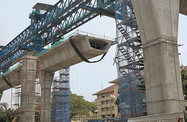The $15bn Exxon-Mobil-led liquefied natural gas (LNG) project has provided the catalyst for Papua New Guinea’s (PNG’s) transport sector’s first major overhaul since gaining independence 37 years ago. Guided by the PNG Development Strategic Plan (PNGDSP) and “Vision 2050”, LNG revenues are already funding an overhaul of national land, sea and air capabilities.
To enable sustainable economic growth – PNG anticipates a six-fold increase in real GDP to PGK56.71bn ($26.7bn) by 2050 – a substantial overhaul of the transport sector will be required. With national attention focused on LNG, priority has shifted to rehabilitating PNG’s fragmented road network and maritime port facilities.
The national road network is largely restricted to main commercial and population centres. While the country is thought to have some 27,000 km of public roads, the exact amount is uncertain. The World Bank estimates that 52% of the population has restricted or no access to roads. Moreover, just 40% of the national road network is considered to be in a condition that can be maintained in a cost-effective manner, according to the Asian Development Bank (ADB).
Leveraging LNG revenues to 2030, the government has in place a number of rehabilitation and construction projects that will triple the national road network, which includes all national routes such as main, district and institutional roads, from 8500 km to 25,000 km, and pave 16 strategically important “missing link” roads throughout the country. The construction of one missing link, which will connect the Western Highlands to Madang – the site of a new port serving PNG’s industrial heartland in the Highlands – is already underway.
PNG estimates that the upgraded road network, which is expected to cost PGK21.35bn ($10.2bn), will facilitate 12.6% economic growth and a 13.1% increase in gross national income, provide more than 154,000 jobs and a PGK1.16bn ($556.53m) rise in tax revenues, according to the PNGDSP and the Medium-Term Development Plan 2011-15.
Notably, while donor-driven investment and aid remains an important contribution, the government intends to fund $9.5bn of the estimated cost through direct financing, tax credits, grants and other fiscal commitments.
Large tracts of PNG’s 5100-km coastline, however, remain solely accessible by ship. As a result, plans have been laid to expand 16 key mainland maritime ports, four of which should be done by 2015. The government expects this will help fuel 3.7% GDP growth by 2030 and reduce chronic congestion at the key gateway ports, Port Moresby and Lae, both of which experienced 30% growth in twenty-foot equivalent unit (TEU) throughput since 2007.
Lae is at the centre of urgent modernisation efforts. State-owned operator PNG Ports is already pursuing an overhaul and modernisation of Lae’s terminal operations and has invested in rubber-tired gantry cranes at both Lae and Port Moresby, which have tripled container movements and quayside storage capacities, according to port officials.
With ADB support, in 2011 ground was also broken on a $330m, 200-metre expansion of Lae’s quay and dockside facilities after a two-year delay. Construction is now expected to be complete in 2014 and the government is aiming to reduce vessels’ turnaround time from three to two-and-a-half days.
While this may not be able to help alleviate immediate congestion attributable to LNG construction, plans are already in the works to accommodate future growth. Just north of the Highlands and a viable alternative to Lae, Madang’s existing port has reached capacity at around 6000 TEU per year. However, the government intends to relocate the port to a larger out-of-town facility by 2015.
Its proximity to the Highlands and completion of roadwork projects should ensure substantial industrial growth in the area. Relocation of Port Moresby’s facilities from its congested and restricted downtown location, however, has yet to make any progress.
While the government has welcomed private-public partnerships, recognising the need for outside expertise, privatisation plans remain off the table. PNG Ports is hesitant to consider this option, fearing that their operations will be cherry picked by investors as Lae, Port Moresby and Kimbe ports subsidise the entirety of their operations. Moreover, the government has re-nationalised divisions of the Department of Works (DoW) that were privatised in the 1990s.
This poses its own challenges to the sector’s rehabilitation, as the government battles internal inefficiencies and resource shortages escalated by the LNG project’s construction demands. Yet the completion of the project’s construction phase in 2014 should see a reduction in material and labour shortages, which will enable the nation’s planned infrastructure projects to move forward on the back of lower costs and an abundance of skilled labour.

